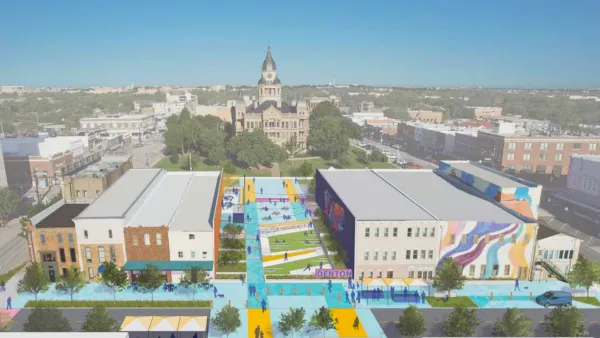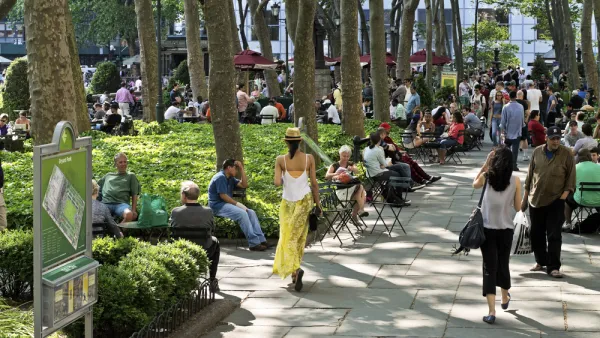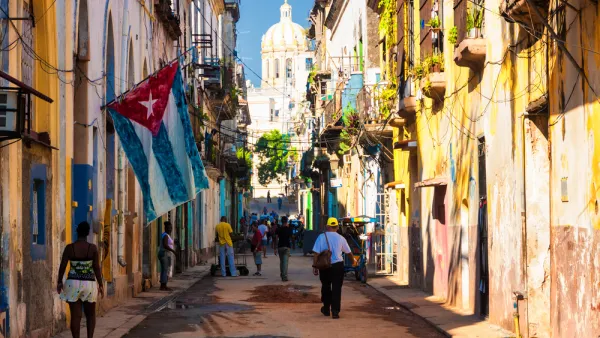Anne Schwartz compiles recent studies on the economic value of parks, describing how an investment in parks by the city will result in a healthier urban economy.
The surge in development spurred by the High Line is the latest exhibit in the growing stack of evidence that having beautiful, well-maintained parks is much more than a nice amenity cities can ignore when times are hard. In a new report Measuring the Economic Value of City Parks, researchers at the Trust for Public Land calculated dollar values for different items.
In San Diego, for example, the study determined that, with slightly less than 5 percent of tourists coming to the city especially to visit the parks, park-derived tourist spending in 2007 totaled $114 million. That generated $8.6 million in direct sales and other tax revenue as well as a collective increase of $40 million in residents' wealth.
By offering free or inexpensive recreation, parks also save residents money. In Boston, for example, the study determined that the economic value of direct park use was $354 million.
The health benefits of exercise in parks offer further savings. The study calculated $19.9 million in medical savings realized by residents in Sacramento because of active recreation in parks.
According to the report, "numerous studies have shown that the more webs of human relationships a neighborhood has, the stronger, safer and more successful it is." Well-used parks offer many ways for neighbors to get to know each other, and efforts to create, save, or care for parks create further community cohesiveness. This "social capital" can reduce a city's costs for policing, fire protection and criminal justice. Because the economic value of social capital can't be measured directly, the report cited as a proxy the amount of time and money residents contributed to "friends" groups and other park-oriented organizations and agencies.
Parks also provide quantifiable environmental benefits: Trees and vegetation absorb runoff and reduce costs for treating stormwater; they also absorb air pollutants. Using Philadelphia as an example, the study found that the city's park system saved $5.9 million in 2007 in stormwater management costs. In 2005, the 4,839 acres of tree cover in 7,999 acres of Washington, D.C. parkland produced savings of $1.13 million in air pollutant removal.
FULL STORY: Good Parks are Good for the Economy

Analysis: Cybertruck Fatality Rate Far Exceeds That of Ford Pinto
The Tesla Cybertruck was recalled seven times last year.

National Parks Layoffs Will Cause Communities to Lose Billions
Thousands of essential park workers were laid off this week, just before the busy spring break season.

Retro-silient?: America’s First “Eco-burb,” The Woodlands Turns 50
A master-planned community north of Houston offers lessons on green infrastructure and resilient design, but falls short of its founder’s lofty affordability and walkability goals.

Test News Post 1
This is a summary

Analysis: Cybertruck Fatality Rate Far Exceeds That of Ford Pinto
The Tesla Cybertruck was recalled seven times last year.

Test News Headline 46
Test for the image on the front page.
Urban Design for Planners 1: Software Tools
This six-course series explores essential urban design concepts using open source software and equips planners with the tools they need to participate fully in the urban design process.
Planning for Universal Design
Learn the tools for implementing Universal Design in planning regulations.
EMC Planning Group, Inc.
Planetizen
Planetizen
Mpact (formerly Rail~Volution)
Great Falls Development Authority, Inc.
HUDs Office of Policy Development and Research
NYU Wagner Graduate School of Public Service




























